Scorpionfishes:
Lionfishes & Much More for Marine Aquariums
Diversity, Selection & Care
New eBook on Amazon: Available
here
New Print Book on Create Space: Available
here
by Robert (Bob) Fenner |
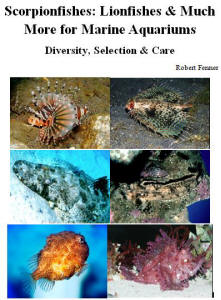 |
Order Scorpaeniformes, the "Mail-Cheeked
Fishes", 25 families, about 166 genera, 1,271 species. There
are " a bunch " of "scorpionfishes" to put it
mildly. All have large heads, most with large eyes and mouths to
match... for the most part sedentary to slow moving, stalking fishes...
many are venomous... with hollow dorsal fin spines that can inject
(with mechanical pressure) powerful proteinaceous toxin... These stings
HURT! Mechanically and chemically. Here we'll list just the
commonly encountered shallow marine species in our area of
Indonesia.
Suborder Dactylopteroidei, Family Dactylopteridae,
the Flying Gurnards. Two genera, about 7 species, three in
Indonesia.
| Dactyloptena orientalis (Cuvier 1829), the
Oriental Flying Gurnard. Indo-Pacific; Red Sea, East Africa to
Hawai'i, Tuamotus, Marquesas. To 40 cm. Demersal; lives on
shallow sandy bottoms. Only member of genus found on oceanic
islands. N. Sulawesi images. |
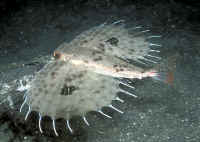
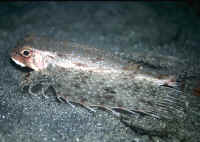
|
Suborder
Scorpaenoidei. Contains world's most venomous fishes. Seven
families, about 96 genera, 544 species.
Family Scorpaenidae, the Scorpionfishes
and Rockfishes. 56 plus genera and 388 species.
Subfamily
Sebastinae, the Rockfishes. Important foodfishes. Four genera, about
128 species.
Subfamily Scorpaeninae, various Scorpionfishes.
15 plus genera with more than 150 species.
Genus Parascorpaena: Seven species. One or two in
Indo.
| Parascorpaena mossambica (Peters 1855), the
Mozambique Scorpionfish. Indo-West Pacific; East Africa to
Australia, the Society Islands. To ten cm. in length. N. Sulawesi
specimen. |
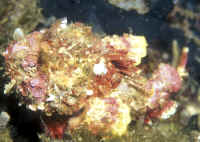
|
Genus Pteroidichthys: Two species.
Pteroidichthys amboinensis Bleeker 1856, the
Ambon or Hairy Scorpionfish. To about three inches in length. West
Pacific. N. Sulawesi (Lembeh Strait) pic. http://www.fishbase.org/Summary
/SpeciesSummary.cfm?
ID=23889&genusname=
Pteroidichthys&speciesname=amboinensis |
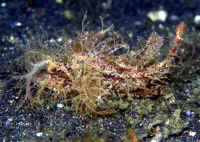
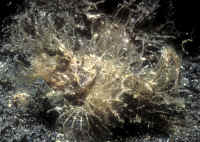
|
Genus Rhinopias:
| Rhinopias frondosa (Gunther 1892), the Weedy
Scorpionfish. Indo-Western Pacific; East coast of Africa to the
Carolines, southern Japan. To 23 cm. in length. N. Sulawesi
specimen by Bob F, close-up of an aquarium specimen by Anthony
C.. |
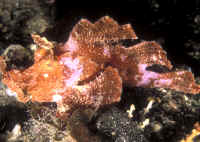
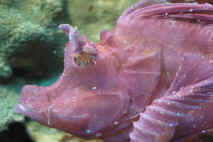
|
Genus Scorpaenopsis:
| Scorpaenopsis diabolus (Cuvier 1829), the
False Scorpionfish. Indo-Pacific; Red Sea to Hawai'i,
Micronesia, Australia. To 30cm. Right, in Hawai'i. Below: N.
Sulawesi images. |
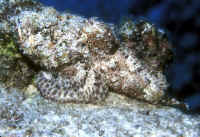
|
| Scorpaenopsis venosa (Cuvier 1829), the
Raggy Scorpionfish. Indo-West Pacific; East Africa to the
Philippines, down to Australia. To a foot in length. Often found
lying on top of soft corals and sponges, disguised, waiting for a
meal to come by. Shown here in N. Sulawesi, Indonesia. |
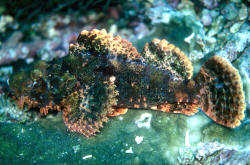
|
Subfamily
Sebastolobinae. Three genera of five species.
Subfamily
Plectrogeninae. One genus, two species.
Subfamily Pteroinae. The Lionfishes and
Turkeyfishes:
| Dendrochirus biocellatus
(Fowler 1928), the Two/Twin-Spot, Roo or Fu Man Chu Lion is
unmistakable with it's two eye spots on the rear dorsal fin
area, and two whisker-like appendages extending from the lower jaw.
To almost five inches in length. A wide-spread species found
throughout the tropical Indian Ocean to the western Pacific,
Mascarenes to Micronesia. Aquarium images. |
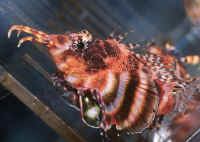
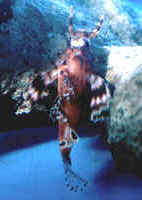
|
|
Dendrochirus brachypterus
("Brack-hip-tur-us") (Cuvier 1829), The Shortfin Dwarf
Lion is a rarer, more heavy bodied dwarf, often showing up with a
good deal of yellow, brown and green mixed with red markings.
Brach dwarfs are aptly named in reference to their very large
pectoral fins with almost no emerging ray tips. This is one of
the most personable marine species, quickly getting to recognize
and respond to it's owners presence. Indo-West Pacific; East
Africa, Red Sea to southern Japan, Australia, Micronesia. Here in
the Red Sea and Mabul, Malaysia.
|
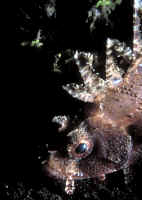
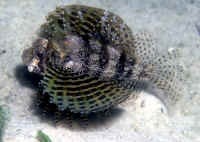
|
|
Dendrochirus zebra (Cuvier 1829), the Zebra
Turkeyfish, is the most common dwarf lion is similar in many ways
and degrees to P. antennata and P. sphex. The one
sure distinguishing mark of D. zebra is the presence of
two white spheres on it's caudal peduncle. To ten inches in
length in the wild. Indo-West Pacific; Red Sea, East Africa, to
Southern Japan, Australia. In Sulawesi.
|
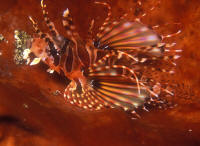

|
| Parapterois heterurus (Bleeker 1856), the
Blackfoot Firefish. Indo-West Pacific; East Africa to Southern
Japan. To eight inches in length. N. Sulawesi (Lembeh Strait)
pic. |
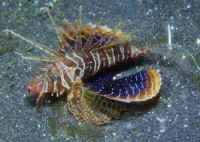
|
|
Pterois antennata (Bloch 1787), the
Antennata Lion or Broad-Banded Firefish to science. This is the
third lion confused with the volitans and Luna species. You
won't make this mistake. Antennata lions have strikingly
different pectoral fin rays. These are long, the thickness of
pencil lead and bright white. Also, remember the connection,
between the name Antennata for it's
relation to the black and white antennae
(supraorbital flaps) and the six prominent spots on their face.
To eight inches long. One in a typical day-time pose (apparently
inverted) in Fiji, the lower in Moorea, French Polynesia, and one
in N. Sulawesi.
|
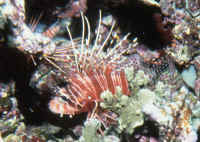 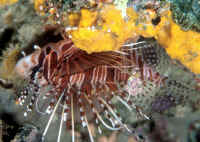
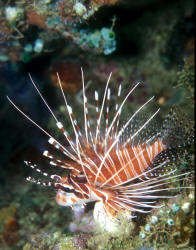
|
| Pterois miles (Bennett 1828), the Devil
Firefish. Indian Ocean and Red Sea. To fourteen inches in length.
An occasional import from the Red Sea, though so similar to the
Volitans and more expensive to transport to the west that is rarely
seen in the U.S. Red Sea images. |
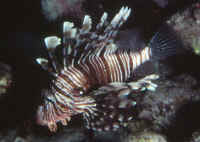
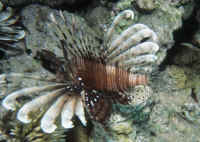 |
| Pterois mombasae (Smith 1957), the Frillfin
or Mombasa Lionfish. Indo-West Pacific; South Africa to Sri Lanka,
New Guinea. To a bit over six inches in length. This one at Quality
Marine in Los Angeles. |
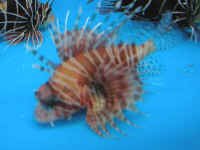
|
|
Pterois radiata Cuvier 1829, the Two-Bar
Lion is the Radial Firefish. The most chameleonic of lions
showing overtones of green, black and various shades of red over
shocking white. The salient identifying characteristic of this
species is the two while horizontal bars on the caudal peduncle,
the part of the body right before the tail. N. Sulawesi and Red
Sea specimens. To nine inches.
|
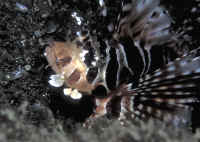
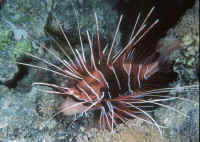
|
Subfamily
Setarchinae. Three genera, five species.
Subfamily
Neosebastinae. Two genera, twelve species.
Subfamily
Apistinae. Three monotypic genera.
Subfamily Tetraroginae, Sailback Scorpionfishes or
Wasp Fishes. 11 plus genera and 35 species.
| Ablabys taenionotus (Cuvier 1829), the
Cockatoo Waspfish. Tropical West Pacific; Indonesia, Philippines,
Australia. To six inches in length. Found on sand and mud bottoms.
N. Sulawesi photos. |
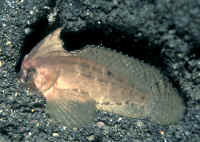
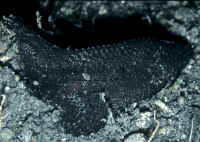
|
| Hypodytes rubripinnis Temminck &
Schlegel 1843. Northwest Pacific; Japan, Philippines. To four and a
quarter inches in length. Aquarium photos. |
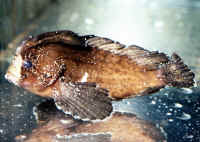
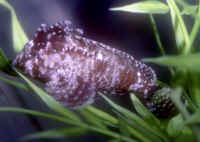
|
| Paracentropogon longispinis (Cuvier 1829),
Wispy Waspfish. To 8 cm. Indo-West Pacific; Thailand, Indonesia,
Australia. Nocturnal for the most part. N. Sulawesi pic. |
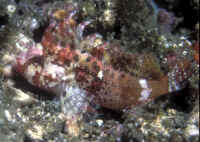
|
Subfamily
Minoinae. One genus, 11 species.
Subfamily Choridactylinae (Inimicinae). Two
genera, ten species.
| Inimicus didactylus (Pallas 1769), the
Bearded Ghoul. Indo-West Pacific; Thailand to Vanuatu, up to China.
To eight and a half inches in length. Very venomous to the touch.
Aquarium photos. Below: Pix in N. Sulawesi. |
/Inimicus_didactylusAQ.jpg)
/Inimicus_didactylusAQ2.jpg)
|
Subfamily Synanceinae, the Stonefishes
proper. Six genera, ten species.
9 Genera, 31 Species: http://fishbase.sinica.edu.tw/Summary/FamilySummary.cfm?ID=578
Family Caracanthidae, Orbicular Velvetfishes.
One genus, four species.
Family Aploactinidae,
the Velvetfishes. Approximately 17 genera and 37 species.
Family Pataecidae,
Australian Prowfishes. Three genera and nine species.
Family Gnathacanthidae, the Red
Velvetfish. One species.
Family Congiopodidae,
the (bizarre) Racehorses, aka Pigfishes, Horsefishes. Four genera, 9
species.
Family Triglidae, the Searobins or Gurnards.
Divided into two subfamilies and three Tribes.
Suborder Platycephaloidei, Crocodilefishes, Flatheads.
Three families, 23 genera, about 75 species.
Family Bembridae, the
Deepwater Flatheads. Four genera, five species.
Family Platycephalidae, Crocodilefishes or
Flatheads. 18 genera of about 60 species.
| Cymbacephalus beauforti (Knapp 1973),
Crocodilefish. Western Pacific. To 50 cm.
Fishbase coverage. N. Sulawesi image. |
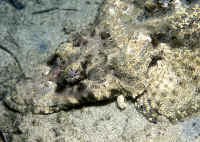
|
Family
Hoplichthyidae, the Ghost Flatheads. One genus, ten species
And more I/we'll eventually list and go over like the
sculpins/cottids, agonids/poachers, hexagrammids/greenlings... but not
today.
Scorpionfishes:
Lionfishes & Much More for Marine Aquariums
Diversity, Selection & Care
New eBook on Amazon: Available
here
New Print Book on Create Space: Available
here
by Robert (Bob) Fenner |
 |

